Believe it or not, one of the more frequent Google searches by which individuals happen upon my blog is a search for “Hebrew Tattoos.” This search, which appears to happen once every few hundred visits to my site, leads readers to my tongue-in-cheek post “Posh Hebrew Tattoos, David! (Beckhams Inscribe their Love).” I have also had individuals email me asking advice on Hebrew tattoos, primarily wanting verification about the spelling of this or that word. My own students also ask similar questions (the latest being just last week).
This interest in Hebrew tattoos intrigues me. It obviously piggy-backs on the popularity of tattoos in general, though I suspect that the fact you have high profile celebrities like David and Victoria Beckham, Madonna, and Britney Spears with Hebrew tattoos boosts their popularity. And, of course, you have the religious crowd that likes tattoos of a biblical character, whether Hebrew, Greek, or even Aramaic.
At any rate, after reproducing the Google search for “Hebrew Tattoos” you will come across a number of web sites that specialize in tattoos, even ones devoted to Hebrew Tattoos that want to cash in on the craze. Most of these sites have sample pictures of actual Hebrew tattoos. What I found troubling is the number of mistakes in these tattoos. As a public service to any individuals thinking of getting a Hebrew tattoo, I thought I would highlight some of the mistakes so that others may avoid them in the future.
Hebrew Tattoos You Don’t Want

This first example of the Hebrew term for “God” makes a simple mistake of confusing Hebrew characters that look similar (of which there are a few!). The bottom letter on the tattoo is a samech (a Hebrew “s”) while it is supposed to be a mem (a Hebrew “m”). Another possibility that Yitzhak Sapir noted in the comments, is that the final letter is the Rashi script for final mem. He suggests that “some Jewish figure who was uncomfortable writing out the name of God changed scripts as a result.” While this is certainly possible, it seems odd that the rest of the tattoo is standard Aramaic square script. I am also not sure how many Jewish tattoo artists are out there who know Rashi’s script! I think my explanation makes a bit more sense. This tattoo is an example of a simple mistake made by someone who was trying to match the letters from a picture or something (I get quite a few papers from students who know a little Hebrew and try to include Hebrew words but they confuse stuff like final mem and samech, resh and dalet, etc.). Either way, if you are going to get a tattoo, it’s probably better to use the same script for the entire thing!
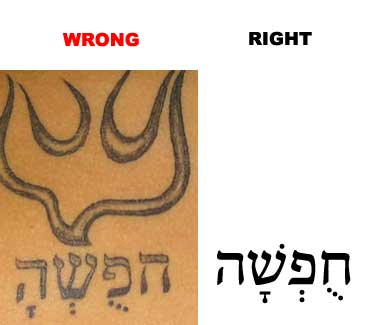
This tattoo, which has a Hebrew word purported by the website I found it on to mean “freedom” (perhaps based on Lev 19:20?) has the vowel points shifted incorrectly to the left. As such it is nonsensical. Moreover, as the comments to this post indicate, in modern Hebrew this word (if correctly pointed) means “vacation” — which I am pretty sure the individual who got the tattoo did not want (especially considering the symbol of the Holy Spirit above it!).
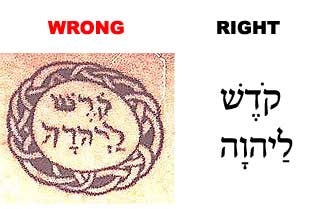
This tattoo, which means “holy to the LORD/Yahweh,” has letters which are either not drawn very carefully or confused (note the difference in width in the second last character in the bottom word; the tattoo has what looks like a dalet or resh, which it should be a vav) as well as incorrect vowel pointing.
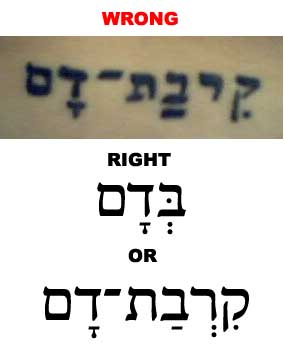
This tattoo is supposed to say “in blood” according to the website where I found it. The expression is not biblical Hebrew, but a modern Hebrew phrase for “blood relative” or the like (see the comments by Yitzhak Sapir). Of course, the tattoo is still incorrect since it is missing the silent sheva after the resh (and the resh looks a bit like a yod). (If I was going to write “in blood” in Biblical Hebrew, I would simply do it as I have it on the bottom.)
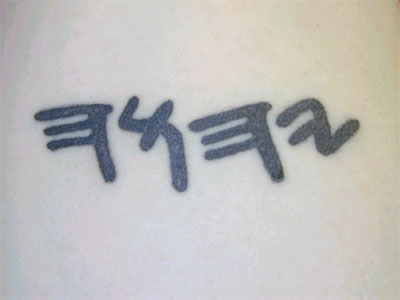
This tattoo of the name of the God of Israel, “Yahweh,” is fine, though the web page identified it as Aramaic. In fact, this is a paleo-Hebrew script of the divine name.
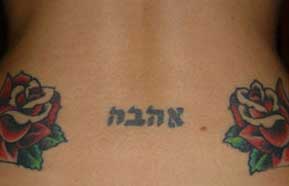
There is nothing wrong with this Hebrew tattoo. I just thought it’s funny because the word inscribed can possibly mean both “love” as well as “leather” (some scholars suggest that there is a homograph [×?הבה II] which means “leather” [see KB3]). It arguably occurs in Hosea 11:4 [perhaps] and Song 3:10 [more likely]). Perhaps this can be taken as a warning not to spend too much time in the tanning salons?! (Of course, in modern Hebrew ×?הבה clearly means love, and as I already noted, there is nothing wrong with this tattoo.)
The lesson here is that you cannot trust pictures of Hebrew tattoos on the internet! Make sure to double check the spelling of the Hebrew word you want tattooed!
Tips for Getting Hebrew Tattoos
If you are thinking of getting a Hebrew tattoo, consider the following:
First, think long and hard about getting a tattoo because they are permanent (notwithstanding modifying tattoos or erasing them). If you are set on the idea of getting a tattoo, think about getting a temporary one first. Also think about where you put your tattoo. Based on the experience of friends, I wouldn’t suggest getting a tattoo on any place where your body may change drastically as you age (and women, beware of tattoos on your stomach as if you ever get pregnant, your tattoo may be stretched beyond recognition (and it may not go back to its original shape — ask my friend!).
Second, if you are getting a Hebrew tattoo, make sure to double check with someone who knows Hebrew (or Greek if you are getting a Greek one) whether or not you have the proper spelling of the word. It would be a bummer to get a tattoo like those above — the only consolation would be that most people wouldn’t know you have a spelling mistake permanently inscribed on your body!
Third, one thing to decide before getting a Hebrew tattoo is whether or not to just use consonants (as Hebrew was originally written) or use consonants with the Masoretic vowel pointing (the little dots and dashes above and below the consonants). The vowel points were added to the text of the Hebrew Bible in the early centuries of this era by Jewish scribes called the Masoretes. While the vowel points represent an ancient reading tradition, they are not original to the Hebrew text, so you may not want to include them. (I personally wouldn’t include them if only for aesthetic reasons)
Finally, make sure to go to a reputable tattoo shop!
As a side note, I don’t have any tattoos nor any intention of getting one — and I hope that this trend will die down by the time my kids are older! My primary problem with tattoos is that they are too permanent; what you may think is cool when you are younger, you may later regret.

That was a lot of fun. I liked the leather/love one myself.
Hi there 🙂
The letter on the top is not a Samech. It is “Rashi” script for final Mem. I suppose that perhaps some Jewish figure who was uncomfortable writing out the name of God changed scripts as a result. The word “in blood” is a Jewish phrase meaning “blood relationship” – קרבת ד×? qirbat dam. The word you label freedom would in Modern Hebrew mean “vacation.” “Freedom” in Modern Hebrew is “hofesh” חפש. How can ×?הבה mean leather?
Best,
Yitzhak Sapir
I don’t see how the right-to-left convention requires a down-to-up convention. After all, Hebrew does write up-to-down. After the first right-to-left line, you then move down the page to the next right-to-left line. Hebrew moves both right-to-left and up-to-down, while English moves primarily left-to-right and then secondarily up-to-down. Some languages move up-to-down primarily and then either left-to-right or right-to-left (e.g. Japanese). I don’t actually know of any that move down-to-up either primarily or secondarily.
Shalom Yitzhak,
If it is not a samech are the other letters also not in Rashi script? You suggest that the tattoo artist or recipient was uncomfortable with writing out “the name of God” (which is not ×?להי×? of course, but יהוה) and so changed the script. Isn’t it more likely they just didn’t know Hebrew and got it wrong?
This reminds me of the tatoo artist who went to jail last year in Orlando. People were coming in to get tatoos with chinese characters thinking they were getting something super original like “love, “freedom”, or”peace”, he would instead tatoo them with words like “poser” and “loser”. I guess we know what he thought of the coolness and originality of those tats.
Two things. First if every one else is doing it are you sure you want to follow that trend? Ten years ago arm bands were “cool”, now they are mocked in commercials, and there are more than a few guys that wish they did something different. Secondly, how about a little bit of originality, just a little? Please? I mean, if you think that getting a tattoo is going to make you cool why not try and do something different. If you go and get a tattoo that many people already have then you are not “cool” you are a lemming. For example,16 year old girls with lower back tats, even worse, if they are a tribal symbol: how original.
Shalom Chris,
I provided a link to a table of Rashi script earlier. Click here. You will see the Mem in Rashi script is rounded, including the top right corner, for example. However, if you will look at the script used by the artist for the rest of the alphabet, the ×” has a square upper right corner. In the square script, a samech would have had the same square corner in the upper right. My theory that he did that because of spelling the name of God is just a theory. However, it does seem odd that he would use two different scripts for the tattoo. It is something like starting off a word in print type and changing to cursive in the last letter. The name of God, from a Jewish point of view, includes both words. So you will hear people say “Elokim” and they will even write it with a ק q to avoid saying the name of God in vain. If the artist or a Jewish friend with whom he consulted for this, felt uncomfortable with using the name of God in vain in a similar manner, this might have been considered by them (although not necessarily by Jewish religious law) a similar solution.
And what about Leviticus 19:28; 21:5 and Tattoos?
Yitzhak, thanks for the great input.
In regards to the first tattoo of “God” (elohim), if the final mem is in the Rashi script, it seems odd that the rest of the tattoo is standard Aramaic square script (as you yourself noted). Your explanation is certainly possible, though I am not sure how many Jewish tattoo artists are out there who know Rashi’s script! I think my explanation makes a bit more sense. It’s a simple mistake made by someone who was trying to match the letters from a picture or something (I get quite a few papers from students who know a little Hebrew and try to include Hebrew words but they confuse stuff like final mem and samech, resh and dalet, etc.). Either way, if you are going to get a tattoo, it’s probably better to use the same script for the entire thing!
I figured the “in blood” tattoo must of had some modern Hebrew thing going since it certainly wasn’t a phrase from biblical Hebrew. Of course, there is still a mistake in the tattoo since it is missing the silent sheva after the resh (and the resh looks a bit like a yod).
In regards to the word ×?הבה “love,” some scholars suggest that there is a homograph (×?הבה II) which means “leather” (see KB3). It arguably occurs in Hosea 11:4 [perhaps] and Song 3:10 [more likely].
Jeremy, you’re right on. I have modified my image. It was one of those thoughts I had in the wee hours of the night that really didn’t make sense!
And Jan, the question of the appropriateness of tattoos in the light of Leviticus 19:28 (“You shall not make any gashes in your flesh for the dead or tattoo any marks upon you: I am the Lord”) and 21:5 (“They shall not make bald spots upon their heads, or shave off the edges of their beards, or make any gashes in their flesh”) is a fair question. I may have to address it in another post. Note, however, that I am not very keen about people getting tattoos. My concern is if they choose to get one, make sure that it isn’t spelled incorrectly!
Note that I have edited my original post with some of these points.
There are frequent reports of such problems with Asian (mainly, but not exclusively, Chinese) scripts at http://hanzismatter.com/ Some of the entries are amusing, others I find rather sad. (For those tempted to think that this is a one-way problem involving silly Westerners, try http://www.engrish.com/.)
I suppose I approve, in a strictly theoretical way, of any attempts to be “cool” by being multi-cultural, however pathetic the specific cases. Certainly more comforting than the reverse!
The Biblical passages may have been over-translated since it is not clear that scarification (a known custom in many cultures) included the concept of tattooing. I have been told (in a lecture; I don’t have my notes, and don’t think they included references, anyway) that Sephardic rulings on tattoos are less categorically prohibitive than Ashkenazic ones, so that some are permitted.
However, if I understood correctly, texts are prohibited even by the “permissive” ruling; possibly out of concern for the sacredness of the letters, possibly because the intention was regarded as likely to be magical. I hope that someone with more precise information can clarify the situation.
After reading your post I decided to talk a bit about tattoos and Jewish law on my blog and brought some links and sources.
http://menachemmendel.blogspot.com/2006/03/hebrew-tattoos.html
I can’t help but post about two of my friends that got tattoo’s a couple of years ago. They asked my advice, and I sais pretty much what you said, try a temporary one, and consider what will happen when having tattoos goes out of fashion. Needless to say they ignored my advice and went straight for the real thing. This backfired somewhat spectacularly on them.
Their intention was to get the word “Yahweh” tattooed on their arms – in english, not even in Hebrew. Unfortunately, in messing around, they ended up confusing the tattooist who did check the spelling with them, (but it appears they were a bit too casual), and as a result the tattooist misspelt it “Yahway”. For Life.
Thankfully they were able to see the funny side…
One of my favorite aspects of these errors is that they are similar to the text critical mistakes sometimes made by scribes, such as the confusion of similar letters (e.g., dalet and resh in the ‘Holy to the Lord’ tatoo).
can you check this one out for me? see if it’s correct?
http://img.photobucket.com/albums/v253/xxalejandro/forever.png
The word with the shifted vowel points is actually a modern Hebrew one, meaning ‘vacation’ (in the sense of ‘holiday’, as we call it on this side of the pond – I am in Oxford, England).
Ahava, love, NEVER EVER means leather in modern Hebrew (and I doubt that it ever did).
The phrase rendered here as ‘in blood’ means ‘blood relationship’, and is perfectly good modern Hebrew (qirvat is the smikhut form of qirva, proximity; qarov (or qrov-mishpaxa) is relative (family relation)). There is, of course, a missing shva, and the resh is not very well drawn, but it’s correct nonetheless.
Tyrell,
Olam means world, not forever. You may want the word “le’olam”, which does mean ‘forever’.
Hey Yoni,
Thanks for your comments on my post.
Your comments on the “freedomâ€? tattoo are correct (as I already noted in response to Yitzhak), though on the webpage where I found the image it said it meant “freedomâ€? and the only place in the Bible where it could possibly mean that would be the Leviticus passage I noted. At any rate, I am pretty sure the individual who got the tattoo did not want a word meaning “vacation” — especially considering the symbol of the Dove (= Holy Spirit) above it!
Your notes on the “in blood� tattoo are correct – as I myself noted in my “update� to that part of the discussion. It is a modern Hebrew phrase (though as you and I also note the vowel points are also incorrect.)
In regards to ahava, my comments were meant to be funny, based on a supposed homonym of the word.
Your comments highlight the issue of whether or not you get a classical/biblical Hebrew tattoo or a modern Hebrew one. Most of the Christians who are getting Hebrew tattoos are getting them because of a particular biblical passage, and thus, biblical Hebrew makes more sense. For instance, in relation to Tyrell Brown’s comments, olam never means “world� in biblical Hebrew. That being said, your recommendation stands for biblical Hebrew as well. le’olam would be more accurate for “forever.�
My comments in relation to Greek were meant to be for those who are getting a Greek tattoo (which are also popular). I clarified my comment.
Anyways… thanks for your comments. I have edited my post to make it clearer.
can someone provide me with the correct lettering for Pirke Avot 1:14
thanks
you could email me @ zdgura@gmail.com or 06zdg@williams.edu
Thanks
Pirke Avot 1:14 is
הו×? ×”×™×” ×?ומ׳ ×?ין ×?× ×™ מי לי וכש×?× ×™ לעצמי מה ×?× ×™ ×?×? ל×? עכשיו ×?מתי׃
Not sure that’s right, Tyler. Shouldn’t it be as follows?
הו×? ×”×™×” ×?ומר: ×?×? ×?ין ×?× ×™ לי מי לי וכש×?× ×™ לעצמי מה ×?× ×™ ו×?×? ל×? עכשו ×?ימתי
Can someone give me the correct translation for “the truth shall set you free” and “you shall know the truth and the truth shall set you free” thank you very much. You can e-mail it to me at teendiva@aol.com
Ashley,
×”×?מת תשלח ×?ותך לחפשי
ותדע ×?ת ×”×?מת וה×?מת תשלח ×?ותך לחפשי
Hi
Can someone give me the correct translation for ” obscured by clouds” and “burning bridges”. Thx if you can, if not thx any way.
Viades,
מוסתר על ידי ×¢× × ×™×?
or
מוסתר ×‘×¢× × ×™×?
For the second, you need to specify whether ‘burning’ modifies ‘bridges’ (bridges that are burning) or it’s a verb (we are burning bridges).
I was wondering if you could show me the hebrew translation of Ezra (it’s my son’s name,) I need it to be big enough so I can print it out and be able to reproduce it. Thanks if you can help!
Wow, I never knew my post would generate so many comments.
I have a few comments:
First, in relation to the quote from Pirke Avot 1.14, my quote is from the Kaufmann A 50 manuscript of the Mishna, while Yoni’s quote is from the Eshkol edition. So I guess you can take your pick, Daniel.
Second, as you are probably aware Ashley, the quote “the truth shall set you free” is from the Gospel of John, chapter 8, verse 32. The gospel (and the rest of the New Testament) was written in ancient Greek, not Hebrew. The verse in Greek is as follows: καὶ γνώσεσθε τὴν ἀλήθειαν, καὶ ἡ ἀλήθεια á¼?λευθεÏ?ώσει ὑμᾶς.
Yoni’s translation above is a great modern Hebrew rendition of the phrases, but if you are wanting “what Jesus said” or the like, then you would need to retrovert the Greek back into first century Hebrew, or better first century Aramaic (which is probably what Jesus spoke).
If I was going to render the Greek expression in ancient Hebrew, I would probably retrovert it something like this:
ותדעו ×?ת ×”×?מת וה×?מת תג×?ל ×?תכ×?
Note that since in the original Greek the “yous” were plural I rendered them with plural in Hebrew; I also used used the verb ×’×?ל which in Biblical Hebrew has the sense of release from slavery, among other things, which I think fits the image of the verse from John. That being said, I don’t think I would get the Hebrew of this verse tattooed on my body, because when it comes right down to it, we don’t know what Jesus said in Hebrew (or Aramaic) – all we have to go by is the original Greek.
Finally, I think I will soon close the comments to this blog post since I wasn’t thinking it would become a venue for asking for the Hebrew wording of this or that phrase. If you want the Biblical Hebrew or Greek wording of a verse, feel free to email me at codex[at]biblical-studies[dot]ca. If you are looking for modern Hebrew, then if Joni indicates his permission to me, I would be happy to include his email or web address.
Thanks for all of the interesting discussion!
hi
It would be “bridges that are burning” and could you please tell me what´s the diference between:
מוסתר ×‘×¢× × ×™×?
מוסתר על ידי ×¢× × ×™×? thank you very much.
Tyler,
Thanks. Yes, I agree with most of your comments. I don’t speak Greek, and didn’t know those were plurals (also, I knew it was a NT phrase but couldn’t locate it).
I would add that
×’×?ל
is usually rendered as ‘redeemed’, and similarly for the other forms – redeemer, redemption etc. Whether that corresponds to ‘set free’ in this context, is not for me to say but rather for an early Christianity scholar (such as yourself) 😉
I have no problem with people contacting me. In fact, my name above is a hot link to my website, so that’s probably the best way to reach me.
Viades:
Burning bridges [bridges that are burning] =
גשרי×? בוערי×?
The difference between the 2 ‘cloud’ phrases is that the shorter one says ‘obscured in clouds’, which is more idiomatic in Hebrew and scans better; while the longer one is literally ‘by clouds’, which doesn’t sound so great (although it’s quite correct Hebrew).
Natalie,
I can’t show you a translation since Ezra is already in Hebrew (or arguably, in Aramaic) 😉
It’s written
עזר×?
If you need larger fonts etc, click on my name to be taken to my website.
I’d be happy to help people, within reason. If it becomes an avalanche (I am told there are 100 a day in the Rockies – is that right?), I may have to make a small charge, since Hebrew translation is my business.
Yoni Kinori:
Thank you very much, you´ve been very helpfull!
and I promise you this will be my last request.
” Mudmen ” and “Mudman” can you help me with these two??
hi, i want to get a hebrew tattoo of the word “pray,” but haven’t found any sites. i was hoping someone on this site could help me out. please send it to my hotmail account: punkrock_promqueen18@hotmail.com
o, and if someone happens to also know the greek symbol for “pray” that would help too. thanks
Viades,
I am not sure I understand your latest – translation or transliteration? And what does it MEAN?
It HAS become an avalanche since I posted that message, I am afraid, so I’ll have to make a small charge. However, you’ll get very good value. Click on my name above to contact me.
BW,
Y.
Yoni Kinory:
Sorry for the (i), I really apreciate the two translations you did for me, in the last one what I was looking for the translation for “mud” and “men”.
And I understand when you say it has become an “avalanche” so no problem. I would like to pay for your seervice but i really can´t ( I have no credit card). 🙁
ABD thank you again.
I would like to get the tattoo “princess” written in hebrew, I looked up the word in a websters englsh to Hebrew dcttionary, Is this correct? How do I know? If someone could please help me find the correct hebrew term for ” princess” it woulld be greatly appricated, thank you!
Hi,
Can anyone tell me what would be the correct way to write a right to left word up and down. If so that would be extremely helpful and also I would like to verify my translation of the word “faith” because I don’t know how credible my source is. If anyone knows that translation I would also be very greatful for it. Thanks
Hi everyone.
Thank you for the many comments. As I mentioned earlier, I have closed the comments to this blog post since I wasn’t thinking it would become a venue for asking for the Hebrew wording of this or that phrase.
If you want the Biblical Hebrew or Greek wording of a verse, feel free to email me at codex[at]biblical-studies[dot]ca. If you are looking for modern Hebrew, then I recommend you check out Yoni Kinory’s website at http://www.hebrewtranslate.net/
Take care,
Tyler
Pingback: Codex: Biblical Studies Blogspot » Blog Archive » David Beckham’s Manly Tattoo
Pingback: Codex: Biblical Studies Blogspot » Blog Archive » Hebrew Tattoos: Buyers Beware! (Best of Codex)
Pingback: Beit Carr » Blog Archive » What’s In A Shem?
Pingback: mayfly » Blog Archive » think before you ink?